
Cell theory
- 1. Concept of life cell as a basic unit of life cell theory By Akanksha Jain Ph.D. Biotechnology
- 2. CELL AS BASIC UNIT OF LIFE The cell is the smallest unit of living matter. The cell is the smallest unit having all the properties of life. All organisms are composed of structural and functional units of life called cells. The body of some organisms like bacteria, protozoans and some algae is made up of a single cell ( Unicellular organisms) while the body of fungi, plants and animals are composed of many cells (Multicellular organisms) Cells vary in size and structure as they are specialized to perform different functions. But the basic components of the cell are common to all cells.
- 3. Robert Hooke (1665), an English scientist, discovered and coined the term cell while examining a thin slice of cork under a self-designed compound microscope. The term cell was derived from a Latin word cellular (meaning little room or chamber). In 1672, Antony Van Leeuwenhoek observed bacteria, sperms and red blood corpuscles, all of which were cells. In 1831, Robert Brown, an Englishman observed that all cells had a centrally positioned body which he termed the nucleus. The crude microscope employed by Robert Hook(1665) MILESTONE IN DISCOVERY OF CELL Thin slice of cork showing chambers/cells
- 4. WHAT IS A CELL ? ( DEFINITION OF CELL ) Cell is the structural and functional unit of living organisms, enclosing a bit of protoplast consisting of numerous micro and macro organic and molecules, dissolved or suspended in colloidal or watery matrix. The molecules are busy in reactions with release or uptake of energy. The protoplasm of the cell is limited by a membrane. All types of cells include three major components 1.Cell membrane 2.Cytoplasm and 3. DNA naked in prokaryotes (Bacteria,Archaea and BGA) and covered by a membrane in all other organisms. Mature Plant cells have in their cytoplasm large vacuole containing non-living inclusions like crystals, pigments etc. The bacteria have neither organelles nor a well formed nucleus.
- 5. Hooke in 1663, observed cork (plant): named the cell Schwann in 1800’s states: all animals are made of cells Pasteur’s work with bacteria ~ 1860 disproved idea of spontaneous generation (living things arise from nonliving matter) Modern cell theory emerged by 1900 DEVELOPMENT OF THE CELL THEORY
- 6. • The Cell Theory states that all organisms are composed of similar units of organization called cells. The Cell Theory states that all organisms are composed of similar units of organization called cells. The cell theory was jointly put forward by Schleiden and Schwann (1839) in their paper “Microscopic investigations on the similarity of structure and growth in animals and plants” : As follows 1) All organisms are composed of one or more cells . 2)Cells are the basic living units within organisms and the chemical reactions of life take place within cells. 3)All cells arise from pre existing cells by division and are not formed de novo In 1855, a German medical doctor named Rudolph Virchow observed, under the microscope, cells dividing. He reasoned that all cells come from other pre-existing cells by cell division Rudolph Virchow Schleiden (PLANT CELL) Schwann (ANIMAL CELL)
- 7. FRANCISCO REDI PROVED THAT MACROORGANISMS DO NOT SPONTANEOUSLY GENERATE People thought that maggots came from meat. Redi disproved this in a controlled experiment
- 8. PASTURE PROVED THAT MICROOGANISMS DO NOT SPONTANEOUSLY GENERATE
- 9. Haeckel (1866) established that nucleus stores and transmits hereditary traits. Cell theory was modified accordingly and was renamed as cell doctrine or cell principle Ernst Haeckel (1834-1919) Modern cell theory includes following features 1. The cell is the fundamental unit of structure and function in living organisms. 2.New cells arise from pre-existing cells through division. All new cells contain the same amount and degree of genetic information as contained in the parent cell 3. Energy flow occurs within cells. 4.Cells contain hereditary information (DNA) which is passed from cell to cell during cell division. 5.All cells are basically the same in chemical composition in organisms of similar species.
- 10. 6. All known living things are made up of one or more cells. 7.Some organisms are made up of only one cell and are known as unicellular organisms. All life begins as a single cell. 8. Others are multicellular, composed of a number of cells. 9.The activity of an organism depends on the total activity of independent cells. 10.Depending upon specific requirement, the cells get modified, e.g. elongated in muscle and nerve cells, loss of nucleus in RBCs or cytoplasm in outer skin cells.
- 11. PRINCIPLES OF MODERN CELL THEORY All organisms composed of cells and cell products. A cell is the simplest structural and functional unit of life. There are no smaller subdivisions of a cell or organism that, in themselves, are alive. An organism’s structure and all of its functions are ultimately due to the activities of its cells. Cells come only from preexisting cells, not from nonliving matter. All life, therefore, traces its ancestry to the same original cells. Because of this common ancestry, the cells of all species have many fundamental similarities in their chemical composition and metabolic mechanisms.